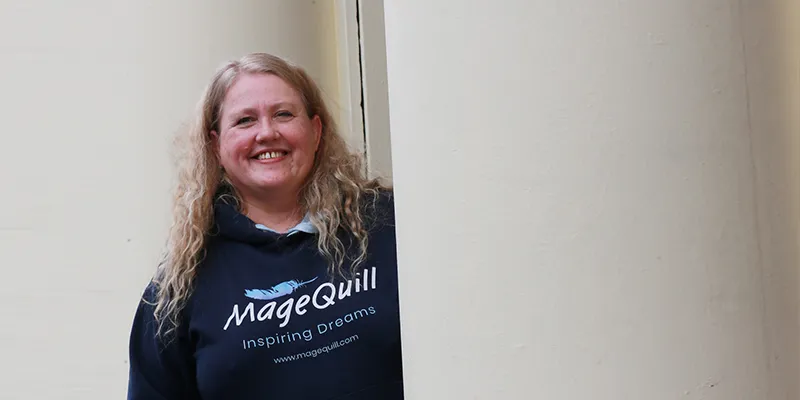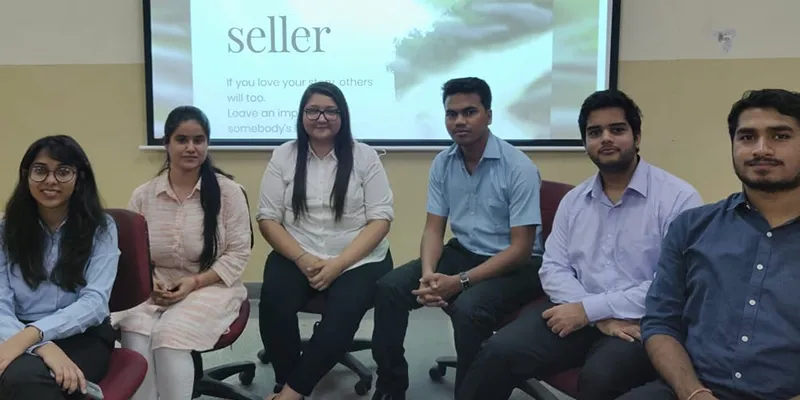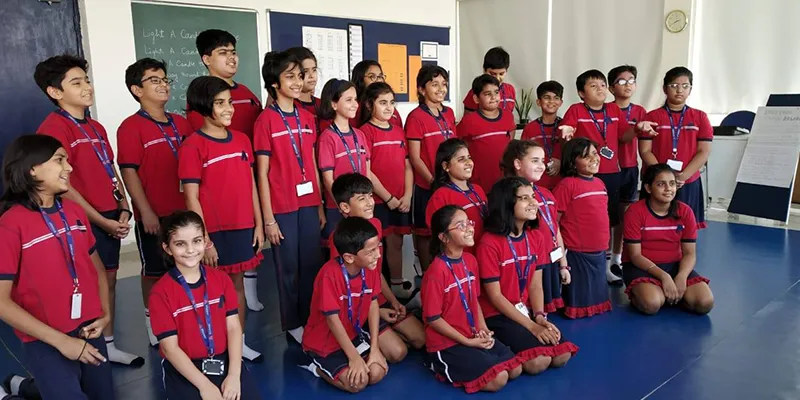How Marianne Rugard Jarvstart’s MageQuill is giving wings to young storytellers in India
The chief of Scotland-based edtech company Mossytop Dreamharvest speaks about the journey of MageQuill, the creative writing tool under its publishing house Bombadil for young storytellers.
How does a story about a world with no green vegetables sound to you? Or a world with 25 hours where the extra hour is spent on another planet? There are plenty of storytellers bursting with stories out there and Mossytop’s Marianne Rugard Jarvstrat wants to give each of them a platform.

Named after Isle of Skye’s prominent peak Mossytop, the Scotland-based edtech company has a publishing division called Bombadil, after the mysterious The Lord of the Rings character. And MageQuill, Bombadil’s creative writing platform for young adults, made its foray into India earlier this year, through its collaboration with the All India Council for Technical Education (AICTE).
It was a conversation over dinner with her 15-year-old nephew that led Marianne to start a publishing platform for young people. The mother of four and I exchange notes across geographies about our love for storytelling, and our responsibilities as pet parents (She has a beautiful horse named Ophelia) and, of course, MageQuill and young writers. Here are excerpts from our conversation:
YourStory: What does MageQuill offer and what did you want to achieve with it?
Marianne Rugard Jarvstrat: MageQuill, our creative writing platform, was developed to bridge storytelling, publishing and education, engaging young people in creative writing in a holistic modern way, where they learn to take responsibility for learning and writing, while collaborating with each other. Quill became an edtech tool merged with a publishing tool when teachers said they needed the system to improve and harness the creativity of their students. MageQuill focuses on the writer, the reader, the teacher and the mentor.
The idea is to start sharing your story in a small positive group to get the feedback you need to improve it for successful exposure to a larger audience.
That also gives confidence, and prepares them for so much more than just being an author. After all, storytelling is an intrinsic part of all of us, and young people are less restricted by what they feel they have to do. We set the age limit of 26, because after that age, a lot of authors start writing to pay the mortgage, rather than for the story itself.

YS: Tell us about yourself and how has this journey been for you?
MRJ: I am a third culture kid. Born in Denmark I travelled will my parents and if there was one thing I realised with all the travelling it was that there is something good in every country and this taught me to listen, especially to stories. I studied veterinary medicine, worked in the travel industry, went on to study business and, thereafter, psychology. Surely, if I studied psychology, I could understand why people put money over empathy and collaboration. Well, I never did, and even taking it to PhD level never gave me that understanding.
However, since 2008, all my attention has been on Bombadil and MageQuill. It has not been easy. Some parts have had to be restarted, remade and rethought, but the idea has always been the same: to give young people a platform to be creative and share their ideas and dreams with each other within a structure of responsibility. We finally got all the pieces together, which feels amazing.
My dream was to empower storytellers. Not have them preached at, or dictated to. It is ok to be yourself, and okay to like the stories you like.
YS: What kind of tech are you using to make something like MageQuill easy, engaging and user-friendly?
MRJ: MageQuill is a creative writing and commenting tool, and thus a bit different from social networks and text editors. However, we have found that writers very quickly grow to enjoy the features and the control they have. We use Drupal as a base for our programming. We started working on the writing part, so that part is now working quite well. We had a user experience auditor go through it, which really showed what should and should not be changed. His suggestions have, with few exceptions, been implemented in the writing tool itself, from the writer and mentor perspective.
YS: Tell us more about the team and the challenges you all face?
MRJ: We have a diverse team with different nationalities. Our team is now 15, though not all are full time. We have a lot of diversity with 10 nationalities, with the youngest being 17 and the oldest being 82. Within our network, we also work with mentors, freelance editors, researchers and are adding more people on a daily basis. We have started our scaling journey, and are in the middle of structuring for a major growth.
Our biggest challenges in scaling up is that we have several areas that all need to be treated differently. It is unusual to scale two such diverse areas as education and publishing. Also, we are up against some very big players who make concerted efforts to dominate the market by excluding others.
Another challenge is that we are up against an 8,000-year-old industry that does not want to change. However, the young people are amazing, and very good at taking opportunities when they arise. They like to have a voice, and like to use it to help each other.
YS: Why did you target India as your market? Why the push towards India? How are you exploring and understanding the needs of the Indian market?
MRJ: I would say that India found us, and we quickly found that there are some extremely talented writers in India. There is also an understanding of the importance of using STEAM (science, technology, engineering, art, and mathematics) rather than merely STEM (science, technology, engineering, and mathematics) subjects, and that shows how mature India is in understanding creativity and education. Also, India has such an amazingly colourful culture of storytelling and it is an absolute delight and honour to be able to not only share in the stories but also work alongside the passions and creativity in India.

There are about 700 people online from India on MageQuill, but with the colleges and individual persons that have requested to be signed up but not yet on the system we will be increasing twentyfold over the next couple of months. We have initially ensured that growth was slow so that we had time to work with the users to iron out any issues. This approach has worked really well and we are anticipating half a million users from India within a year and a million globally.
Apart from MageQuill and its creativity ethos being a brilliant fit in India, there are two other reasons for our increased presence in India. One is our ongoing lore competition, where we now also have who we lovingly call ‘our mini-quills’ - students aged seven to 11, and the second is that we are working with the colleges under the auspices of the AICTE.
We have had an amazing take-up of new users since end of March when we went live in India during the hackathon. Our business model is two-fold: schools using MageQuill for education pay a subscription fee. That gives them a teacher dashboard providing an overview of information that help the teachers to identify the needs of their class, and keep track of the students’ progress. On the other hand, writing is free, because as publishers we want lots of stories. A publishing company survives on a single bestseller every three years, and if we have enough writers, and knowing that one in a hundred have written a full-length book, then we will soon find the next bestseller. We are careful that all writers not only retain copyright to their own work, but that they also get generous royalties.
YS: What kind of traction have you seen in India? Has that pushed you to move to new markets?
MRJ: I am amazed at the stories that we pick up in India and the creativity there. There are no limits to the energy and passion from the stories and their creators, some even as young as seven. When we just did publishing we saw some amazing work in India, but now with MageQuill we see a much broader picture. We love how young people can relate across borders and we love how the Indian youth are able to be so confident and happy to embark on a journey on discovery and creativity.

Because of our success in India, and the take-up that is starting in China, we are starting up an office in Singapore, and will then be able to reach out even more from there. We are also looking to raise funding so we can set up a big presence in India and build on the creative community spirit.
MageQuill’s heart is firmly in India, and the tool, together with the MageQuill cat (the mascot) have been lovingly adopted by so many amazing storytellers. It really is a privilege to be part of a global success story.
YS: What are the next steps? How does the road forward appear?
MRJ: Next year, we are planning to do a roadshow where we can visit schools, colleges, talk to some of the new authors and showcase old authors.
****
Marianne draws strength and creativity from young people. “Every time I have had enough of 16-hour days, or when something has not worked, or a server crashed, I just have to interact with the young writers and discuss their stories with them. That always allows me to walk that extra mile,” she signs off.
She shares the work of a young Indian poet, Sreemay Rath whose work blew her over. She shares one of his poems:
Strings
The stars are
suspended by
strings,
I can promise
you
the moon, the sun
the clouds,
airplanes, and some
delineated birds
all suspended by ropes
and wires
and we are the only ones
not tethered by
anything,
yet we often believe
that we are.
If you're a woman and an entrepreneur, help us compile a directory of women-led businesses in India by taking this quick survey.







